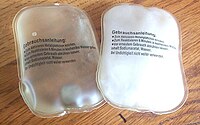
Photo from wikipedia
Graphitic phase carbon nitride (g-C3N4) is a promising photocatalytic environmental material. For this study, the graphitic phase carbon nitride was prepared using a thermal polymerization method. The characteristic peaks, structures,… Click to show full abstract
Graphitic phase carbon nitride (g-C3N4) is a promising photocatalytic environmental material. For this study, the graphitic phase carbon nitride was prepared using a thermal polymerization method. The characteristic peaks, structures, and morphologies were determined using Fourier-transform infrared spectroscopy (FT-IR), X-ray diffractometry (XRD), and scanning electron microscopy (SEM), respectively. Under the synergetic visible light catalysis of H2O2 and Na2S2O8, the degradation effects of g-C3N4 on the anionic dye methyl orange (MO) and the cationic dye rhodamine b (Rhb) were investigated. The effects of adding different volumes of H2O2 and Na2S2O8 were likewise tested. The results showed that the above two synergistic systems increased the degradation rates of MO and Rhb by 2.5 and 3.5 times, respectively, compared with pure g-C3N4, and that the degradation rates of both MO and Rhb reached 100% within 120 min and 90 min, respectively, in accordance with the primary reaction kinetics. When H2O2 and Na2S2O8 were added dropwise at 10 mL each, the degradation rates of MO and Rhb were 82.22% and 99.81%, respectively, after 30 min of open light. The results of experiments upon both zeta potential and radical quenching showed that ·OH and ·O2− were the main active radicals for dye degradation in our synergistic system. In addition, stability tests showed that the photocatalysts in the synergistic system still had good reusability. Therefore, the use of a synergistic system can effectively reduce the photogenerated electron-hole pair complexation rate, representing a significant improvement in both photocatalytic degradation and for stability levels.
Journal Title: Molecules
Year Published: 2023
Link to full text (if available)
Share on Social Media: Sign Up to like & get
recommendations!